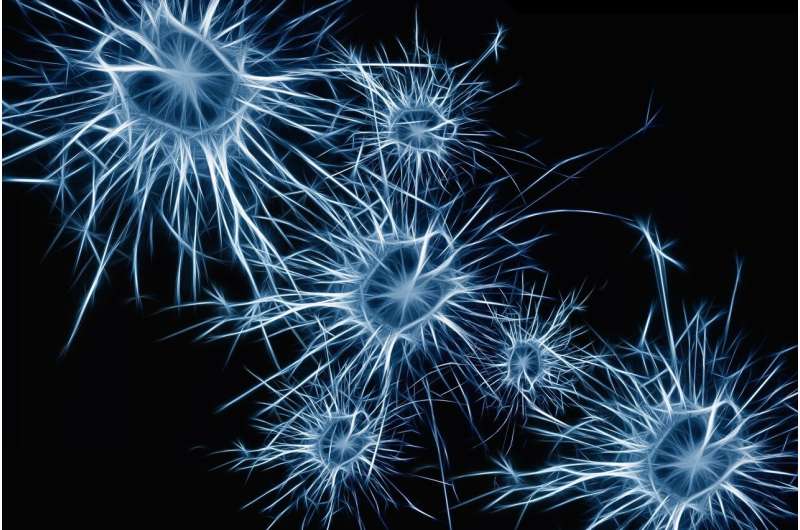This article has been reviewed according to Science X's editorial process and policies. Editors have highlighted the following attributes while ensuring the content's credibility:
fact-checked
peer-reviewed publication
reputable news agency
proofread
What makes us human? Researchers uncover clues behind brain evolution

The human brain is three times bigger than a chimp's and more spherical than a Neanderthal's. Within a maze of bumps and grooves, neurons converse in distinct patterns that give humans unique cognitive abilities.
Scientists haven't fully deciphered those patterns. But researchers at UT Southwestern Medical Center are determined to solve the molecular mystery of what makes us human.
In a study published in the journal Nature, they compared brain cell types and activities among humans, chimpanzees and rhesus monkeys. Human brains had more of a kind of cell that may help them adapt based on new experience and heal from injury. Certain human neurons also had more of a gene that affects language development.
Genevieve Konopka, whose lab ran the study, has long investigated the molecular mechanisms that lead to brain disease. Understanding the human brain's inner workings, she said, may help researchers develop therapies to treat conditions like Alzheimer's and schizophrenia.
The brain's support crew
Our brains set us apart from other primates. Humans communicate in languages that chimps can't speak and devise systems of government and religion that don't exist in the animal kingdom.
Though scientists have compared the cell types and genes in the brains of humans and other primates, they still lack a complete knowledge of how the human brain came to be over millions of years of evolution.
Konopka's inquiry into brain evolution stemmed from her study of brain disease. In 2019, she compared brain tissue in people with and without schizophrenia and found differences in cells called oligodendrocytes. These cells act like the brain's support crew, producing insulation that wraps around neurons and helps them send signals faster.
Konopka also saw a difference in oligodendrocytes between human and chimp brains. She realized this support crew could play an important role in both brain disease and human brain evolution.
Konopka wasn't able to pursue her research further because of technological limits. But in recent years brain studies got a boost from single-cell technology, which allows scientists to capture each cell in a piece of brain tissue and examine the activity of different genes.
Using this technology, Konopka focused on a part of the brain located in what's called the posterior cingulate cortex. This part is implicated in schizophrenia and is associated with the way we think about ourselves. Konopka said her lab is the first to apply single-cell technology to this region of the brain.
Her lab compared oligodendrocyte amounts and gene activity in human, chimp and rhesus monkey brain tissue. In another experiment, they compared human DNA with genetic information from two ancient human populations: Neanderthals and Denisovans.
Waiting in the wings
Konopka thought her lab would find more oligodendrocytes in human brain tissue compared to that of chimps and rhesus monkeys.
Instead, she found a human-specific increase and gene activity changes in pre-oligodendrocytes: brain cells that haven't yet evolved to perform their mature functions.
At first, Konopka thought it was a mistake. But after confirming the result, she said, it began to make sense. More pre-oligodendrocytes may help the human brain adapt in response to change or injury, she explained. Having more of these cells may allow us to continue learning into adulthood.
Her lab also found that a gene called FOXP2, which is associated with language development in humans, had higher expression in two types of human neurons. Konopka said the human-specific increase could contribute to the language of human thoughts.
The lab also identified hundreds of genes that may function differently in humans, Neanderthals and Denisovans. These differences shed light on how the human brain evolved over the last 300,000 to 500,000 years, Konopka said.
Konopka's research adds to the field by not only investigating which genes exist in different brain cells, but also how active they are, according to Doug Broadfield, an associate professor of cell biology at the University of Miami Miller School of Medicine.
"What's new about this study is that it's … created a new field of brain evolution," said Broadfield, who was not involved with the research, "where instead of focusing on the structure of the brain, now we can look at the genetic activity of the brain."
Konopka hopes to next use single-cell technology to examine brain tissue from people with brain disorders, including schizophrenia.
"We just wanted to set the table, if you will, for future studies looking at brain disease," she said.
More information: Emre Caglayan et al, Molecular features driving cellular complexity of human brain evolution, Nature (2023). DOI: 10.1038/s41586-023-06338-4
2023 The Dallas Morning News. Distributed by Tribune Content Agency, LLC.



















